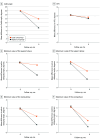Digital Physiotherapeutic Scoliosis-Specific Exercises for Adolescent Idiopathic Scoliosis: A Randomized Clinical Trial
- PMID: 39964686
- PMCID: PMC11836762
- DOI: 10.1001/jamanetworkopen.2024.59929
Digital Physiotherapeutic Scoliosis-Specific Exercises for Adolescent Idiopathic Scoliosis: A Randomized Clinical Trial
Abstract
Importance: The effectiveness of a training support program of individually tailored physiotherapeutic scoliosis-specific exercises (PSSEs) delivered via a digital care system is unclear.
Objective: To determine the effectiveness of a digital care program in which patients receive PSSE supervision and guidance via the Healbone Intelligent Rehabilitation System and educational videos compared with a conventional intervention involving 3 treatment sessions conducted by qualified physiotherapists at outpatient clinics or specialized orthopedic institutions and unsupervised home-based PSSE training.
Design, setting, and participants: This randomized clinical trial recruited patients aged 9 to 17 years from Peking Union Medical College Hospital in Beijing, China, who had adolescent idiopathic scoliosis with a primary curve Cobb angle of 10° or greater and skeletal immaturity (as determined via the Risser grading system). The trial was conducted from June 1, 2023, to August 10, 2024.
Interventions: Patients were randomly assigned to a digital care (DC) group, in which each patient received fully remote and home-based PSSE training supported by a digital care system, or a usual care group, in which each patient completed 3 treatment sessions conducted by qualified physiotherapists at outpatient clinics or specialized orthopedic institutions and home-based PSSE training without supervision.
Main outcomes and measures: The primary outcome was a change in the Cobb angle of the major curve between baseline and month 6 of the intervention. Primary and secondary outcomes were evaluated using an independent samples t test. The proportion of patients who exhibited disease progression or improvement in the Cobb angle between the 2 groups was compared using a χ2 test.
Results: Of 591 patients assessed for eligibility, 436 did not meet the eligibility criteria, 12 declined to participate, and 15 withdrew before randomization. The remaining 128 patients were randomized to 2 parallel groups, with 64 patients in each group (mean [SD] age, 11.1 (2.2) years; 97 female [75.8%]), all of whom completed the baseline assessment and 6-month follow-up. The mean difference in the improvement of the Cobb angle between the DC group and the usual care group after a 6-month intervention was -4.23° (95% CI, -6.08° to -2.39°) in the intention-to-treat analysis and -4.01° (95% CI, -5.68° to -2.35°) in the per-protocol analysis. The posttreatment Cobb angle was adjusted by using analysis of covariance, and the mean of the difference in the adjusted posttreatment Cobb angle between 2 groups was -4.24° (95% CI, -6.09° to -2.38°).
Conclusions and relevance: In this randomized clinical trial, the effectiveness of individually tailored PSSE training support delivered via a digital care system was superior to that of a conventional PSSE training model in improving the Cobb angle. This mode of exercise may be an effective and convenient alternative for individuals with adolescent idiopathic scoliosis.
Trial registration: Chinese Clinical Trial Registry Identifier: ChiCTR2300076563.
Conflict of interest statement
Figures


References
-
- Kuznia AL, Hernandez AK, Lee LU. Adolescent idiopathic scoliosis: common questions and answers. Am Fam Physician. 2020;101(1):19-23. - PubMed
Publication types
MeSH terms
Associated data
LinkOut - more resources
Full Text Sources
Medical

